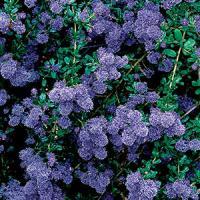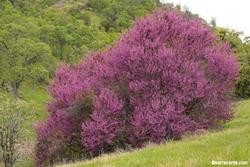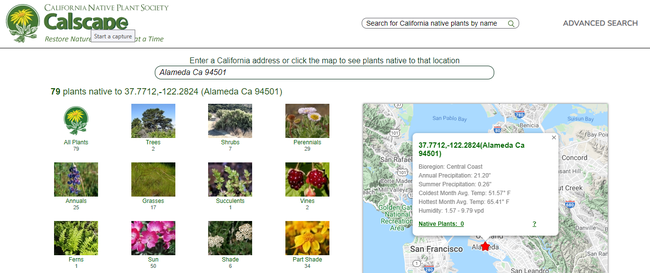Planting California Natives
Planting California Natives: The Time is Now [Fall/Winter]
by Linda Carloni
Plants that are native to California are becoming more and more popular, as part of existing garden beds, and landscapes or to replace a lawn. Here’s a rundown on why and how to plant them, together with resources to dig deeper.Why Plant California Natives?
Local native plants offer many benefits:
- Insect populations are rapidly diminishing. Insects are critical to pollination, decomposing plant materials, moving seeds around, balancing the populations of other organisms, and providing food at the base of the food chain. So it’s good to encourage insects when we can, and studies have shown that generally more insects are attracted to natives, probably because the insects and the plants co-evolved together.
- Native plants provide excellent habitat for birds and butterflies, again because the plants, insects, and birds evolved together.
- Native plants are frequently, although not always, drought-tolerant once established, critical in our increasingly warm and dry Bay Area.
- They generally have few pest problems, which lets the gardener avoid using pesticides.
What Natives Should I Plant?
A wide variety of California native plants are commercially available. You can find California native trees, shrubs, smaller perennials and annuals, vines, and groundcovers. Many natives prefer full sun, but some do as well or better in shade or part sun. Almost any type of native soil has native plants adapted to it - sand, soil, loam, and even rocky or salty soils. With a bit of work, you can select natives that will provide blooms in your yard over almost the whole year.The variety can make your plant selection seem overwhelming. California Native Plant Society’s CalScape is an amazing online tool for helping to narrow down what plants are likely to do best in a particular location (you can even enter your address to get a list of natives for your exact area). To find a specific plant, start searching by the plant’s common or Latin name to get a full description. The Advanced Search tool enables searching for plants that have your desired characteristics in geographical location, sun and shade needs, drainage, water requirements, ease of care, soil type, and many other characteristics.
If you are interested in attracting particular wildlife, CalScape tells you generally what wildlife uses a plant. The UC Berkeley Urban Bee Labs have posted a list of best bee plants for California, identifying which of those are California natives. The Santa Clara County Master Gardeners have provided a list of native plants that attract pest-eating insects.Another way of selecting plants is to look around your greater neighborhood to see what native plants are growing well. Native plants are sometimes organized into plant communities, which means groups of plants are growing together in a particular environment (soil, temperature, moisture, etc.) Two plant communities found frequently in Alameda County are Coastal Sage Scrub and Central (sometimes called Foothill) Oak Woodland.
Coastal Sage Scrub
In Coastal Sage Scrub, you’ll typically find California Sagebrush, Buckwheats, California Lilac (Ceanothus), Manzanitas, Sages (Salvias), Currants (Ribes), California Poppies, and many more.
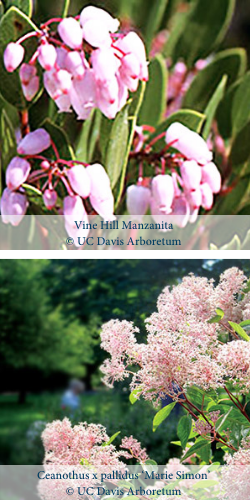
Central Oak Woodland
In Central Oak Woodland, you’ll find overlap and more trees. Important plants include Coast Live Oak, other oaks, California Buckeye, California Bay Laurel, Toyon, Manzanita, Coffeeberry, Currants, and Sticky Monkeyflower.
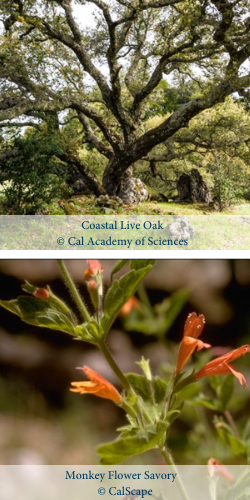
Nine Native Planting Tips
- Plant Now [fall/winter]. Perhaps the most important thing to know about growing California natives is to plant in late fall to early winter when the rains will hopefully provide the plants a good start.
- Moist, not wet. Particularly in winter, take care not to plant when the soil is too wet. The natural pockets, or pores, between soil particles are crucial to healthy plant growth. Digging in wet soil -- or even walking on it -- compacts those pores. Clay soils are particularly susceptible to this damage. If it has rained recently, do a squeeze test before planting. Dig up a trowel’s worth of soil and squeeze it in your hand. If it sticks together in a ball, wait a few days and test again.
- Remember that they will grow. Like all plants, give natives the space they need to reach their mature size. The mature size may be stated on the pot, or you can find it on Calscape. The plants may look a little sparse when planted, but will quickly fill in and will be far healthier than were they crowded together.
- Dig the right hole. When you are ready to plant, make a hole slightly less deep than the soil in the pot and twice as wide as the pot. Roughen the soil on the sides of the hole if needed. Fill the hole with water and let it thoroughly drain.
- Plant high. Before planting, thoroughly water the plant while it is still in the nursery pot, and let it drain very well. Gently remove the plant from its pot and place it in the middle of the hole so that the point where the stem emerges from the pot soil is about ½ inch above the planting site soil surface. If needed, add back more native soil under the plant. When it is the right height, backfill the hole with native soil, patting it down firmly to remove any air pockets. Use soil to make a little berm where the edges of the hole were. What you want to end up with is the plant on a ½ inch ”plant island” with a shallow moat around it to hold water. Water thoroughly.
- Mulch! When the soil has drained at the surface, apply an inch or two of mulch, leaving 3 to 4 inches of clear space around the crown (where the roots meet the stem).
- Consider Nutrients. Generally, natives get the nutrients they need from the native soil and need no amendment or fertilizer. If your soil is very sandy and the native is not a beach plant, you might add some compost for organic matter.
- Water. Even if a native plant needs little to no water during most of its life, virtually all newly planted natives will need watering during non-rainy periods to become established. Most natives will need watering until the rains start after their first summer. Before watering, always check the root ball to see if it is damp; if it’s damp, you don’t need to water. Check CalScape for hints as to whether summer water is needed, tolerated, or to be avoided for your particular plant and environment.
- Don’t do too much. California native plants generally don’t require that much maintenance. Prune with caution. Native pruning is different than for non-natives. Deadheading is OK but many native gardeners leave the seeds to ripen for birds. Likewise, avoid fertilizer. Many natives have evolved their own pest management techniques, so if you see pests, wait a bit to see if the plant manages them on its own. And take care with water - many a Ceanothus has been killed by too much summer water!
We live in an incredibly biodiverse state – why not help hang onto that biodiversity by planting some California natives this winter?
Resources
- UC Berkeley Native Bee Labs
- CalScape
- Santa Clara County Master Gardeners on creating beneficial insect habitat
- Marin County Master Gardeners on natives, native plant communities and pruning natives
Still need help?
Email us at acmg@ucanr.edu. Or contact us through our website http://acmg.ucanr.edu/Contact_Us/ .


